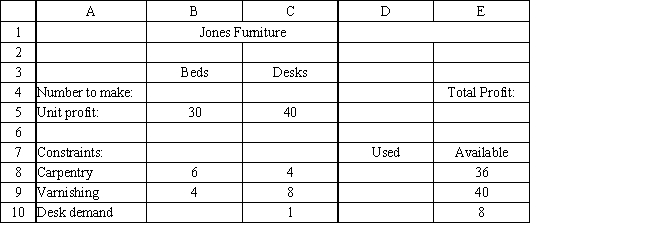Exhibit 3.1
The following questions are based on this problem and accompanying Excel windows.
Jones Furniture Company produces beds and desks for college students. The production process requires carpentry and varnishing. Each bed requires 6 hours of carpentry and 4 hour of varnishing. Each desk requires 4 hours of carpentry and 8 hours of varnishing. There are 36 hours of carpentry time and 40 hours of varnishing time available. Beds generate $30 of profit and desks generate $40 of profit. Demand for desks is limited, so at most 8 will be produced.  The LP model for the problem is
The LP model for the problem is 

-Refer to Exhibit 3.1. Which of the following statements represent the carpentry, varnishing and limited demand for desks constraints?
A) B4:C4 ≤ B5:C5
B) E5 ≤ 0
C) D8:D10 ≤ E8:E10
D) E8:E10 ≤ D8:D10
Correct Answer:
Verified
Q2: In modeling a problem it is usually
Q3: The LHS value of a constraint represents
Q4: Which type of spreadsheet cell represents the
Q5: Decision variables are sometimes referred to as
Q6: Solving LP problems in Excel requires only
Q7: Using Data Envelopment Analysis (DEA) for an
Q8: Exhibit 3.3
The following questions are based on
Q9: Exhibit 3.5
The following questions are based on
Q10: What does the Excel "=SUMPRODUCT(A1:A5,C6;C10)" function do?
A)
Q11: Analytic Solver Platform (ASP) is functionally similar
Unlock this Answer For Free Now!
View this answer and more for free by performing one of the following actions

Scan the QR code to install the App and get 2 free unlocks

Unlock quizzes for free by uploading documents